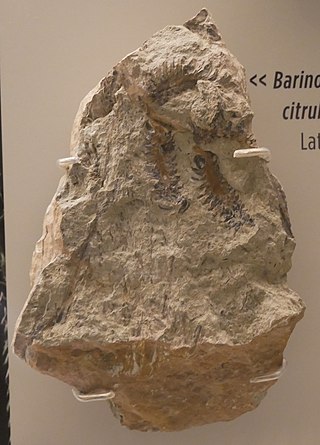Barinophyton
Extinct genus of plants From Wikipedia, the free encyclopedia
Barinophyton was a genus of early land plant with branching axes. It is placed in a group of early vascular plants (tracheophytes), the barinophytes, a group that has been given various ranks and scientific names.[4] Known fossils are of Devonian to Carboniferous age (420 to 299 million years ago).[1]
| Barinophyton Temporal range: | |
|---|---|
 | |
| Barinophyton citruliforme fossil, New York State Museum | |
| Scientific classification | |
| Kingdom: | Plantae |
| Clade: | Tracheophytes |
| Clade: | †Barinophytes |
| Genus: | †Barinophyton White (1905)[2] emend. Brauer (1980)[3] |
| Species | |
| |
| Synonyms | |
| |
Phylogeny
Summarize
Perspective
Kenrick and Crane in 1997 placed two species of Barinophyton along with the genus Protobarinophyton in the Barinophytaceae in their Sawdoniales, well nested within the zosterophylls.[5] A summary cladogram produced by Crane et al. in 2004, shows Barinophyton in the core of a paraphyletic stem group of broadly defined zosterophylls, basal to the lycopsids (living and extinct clubmosses and relatives).[6]
| lycophytes |
| |||||||||||||||||||||
The phylogenetic position of the barinophytes remains disputed. Taylor et al. in 2009 considered the barinophytes to be possible lycopsids rather than zosterophylls.[1] Hao and Xue in 2013 suggested that they were not lycopsids, instead falling between this group and the euphyllophytes.[7]
References
External links
Wikiwand - on
Seamless Wikipedia browsing. On steroids.
